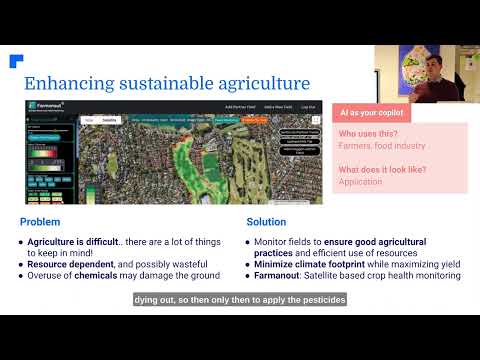US Graphite Industry Breakthrough: Reshaping the Battery Materials Supply Chain
“China supplies over 80% of global graphite, prompting US concerns about battery material supply chain security.”
In recent years, we’ve witnessed a significant shift in the global battery materials industry, particularly in the realm of graphite production and supply. As experts in the field, we at Farmonaut have been closely monitoring these developments and their potential impact on various sectors, including agriculture and technology. Today, we’ll delve into the intricacies of the US graphite industry breakthrough and how it’s reshaping the battery materials supply chain.
The Current Landscape of the Graphite Industry
Before we explore the recent breakthroughs, it’s crucial to understand the current state of the graphite industry, particularly in relation to battery production. Graphite is a critical component in lithium-ion batteries, serving as the primary material for anodes. The demand for graphite has skyrocketed in recent years, driven by the rapid growth of electric vehicles (EVs) and renewable energy storage systems.
- China dominates the global graphite supply, accounting for over 80% of production
- The US has been heavily reliant on Chinese graphite imports
- Concerns about supply chain security and national security have been growing
This dominance has raised alarms in the United States, prompting a reevaluation of the domestic graphite industry and its potential for growth.

The US Graphite Industry Breakthrough
In a significant turn of events, the US graphite industry has recently experienced a breakthrough that promises to reshape the battery materials supply chain. This development comes at a crucial time when the demand for electric vehicle battery materials is soaring, and the need for a robust domestic supply chain has never been more apparent.
Key Developments:
- International Trade Commission (ITC) Determination: The ITC has made a preliminary determination that Chinese graphite exports are being sold at artificially low prices, undermining US producers.
- Potential Tariffs: This decision could lead to the implementation of tariffs on Chinese graphite imports, leveling the playing field for domestic producers.
- Increased Domestic Production: North American graphite producers are gearing up to boost synthetic graphite production significantly.
- Strategic Importance: The US government has recognized graphite as a critical mineral, emphasizing its importance for national security and economic prosperity.
These developments are poised to have far-reaching implications for the battery anode materials market and the broader lithium-ion battery supply chain.
Impact on the Battery Materials Supply Chain
The US graphite industry breakthrough is set to reshape the battery materials supply chain in several ways:
- Reduced Dependence on Foreign Imports: By ramping up domestic production, the US aims to decrease its reliance on Chinese graphite exports.
- Enhanced Supply Chain Security: A more diversified supply chain will help mitigate risks associated with geopolitical tensions or supply disruptions.
- Potential Cost Implications: While tariffs may initially lead to higher prices, increased competition and domestic production could stabilize costs in the long run.
- Accelerated Innovation: The push for domestic production is likely to spur research and development in graphite technology and battery materials.
As we at Farmonaut continue to innovate in the agricultural technology sector, we recognize the importance of a stable and secure supply chain for critical materials like graphite. While our focus remains on providing cutting-edge satellite-based farm management solutions, we understand that advancements in battery technology can have profound implications for the agricultural sector, particularly in the realm of electric farm equipment and sustainable energy storage.
The Role of Government Policies and International Trade
The recent developments in the US graphite industry highlight the intricate relationship between government policies, international trade, and strategic industries. The US government’s actions to protect and nurture the domestic graphite industry are part of a broader strategy to secure critical mineral supply chains.
Key Policy Initiatives:
- Critical Minerals List: Graphite’s inclusion on this list underscores its importance to national security and economic prosperity.
- Trade Measures: The potential implementation of tariffs on Chinese graphite imports is aimed at creating a more level playing field for US producers.
- Domestic Production Incentives: Government support for research, development, and production of graphite and other battery materials.
- International Partnerships: Collaboration with allies to diversify supply chains and reduce reliance on a single dominant supplier.
These policy initiatives are reshaping the competitive landscape of the graphite industry and have significant implications for global trade dynamics.
Comparative Analysis: US vs. Chinese Graphite Industry
To better understand the current state of the graphite industry and the potential impact of recent developments, let’s examine a comparative analysis of the US and Chinese graphite industries:
| Aspect | United States | China | Other Countries |
|---|---|---|---|
| Production Capacity (est. tons/year) | 50,000 | 1,000,000 | 200,000 |
| Market Share (%) | 5% | 80% | 15% |
| Export Volume (est. tons/year) | 10,000 | 800,000 | 100,000 |
| Price per Ton (est. USD) | $3,500 | $2,800 | $3,200 |
| Government Subsidies | Limited | Extensive | Varies |
| Environmental Regulations | High | Medium | Varies |
| R&D Investment | High | High | Medium |
This comparison illustrates the significant disparities between the US and Chinese graphite industries, particularly in terms of production capacity and market share. However, it also highlights areas where the US industry has potential advantages, such as stricter environmental regulations and high R&D investment.
The Future of Synthetic Graphite Production
“North American producers aim to increase synthetic graphite production by 300% to reduce foreign import dependence.”
One of the most promising aspects of the US graphite industry breakthrough is the focus on increasing synthetic graphite production. Synthetic graphite offers several advantages over natural graphite, including higher purity and more consistent quality, which are crucial for high-performance batteries.
Advantages of Synthetic Graphite:
- Higher purity levels, resulting in better battery performance
- More consistent quality, leading to improved manufacturing processes
- Customizable properties to meet specific battery requirements
- Reduced environmental impact compared to natural graphite mining
As North American producers ramp up synthetic graphite production, we can expect to see significant advancements in battery technology and performance. This shift towards domestic synthetic graphite production aligns well with the growing demand for high-quality battery materials in the electric vehicle and energy storage sectors.

Implications for the Electric Vehicle Battery Materials Sector
The US graphite industry breakthrough has significant implications for the electric vehicle (EV) battery materials sector. As the automotive industry continues its rapid transition towards electrification, the demand for high-quality graphite and other battery materials is skyrocketing.
Key Impacts:
- Supply Chain Resilience: A more diversified graphite supply chain will help EV manufacturers mitigate risks associated with supply disruptions or geopolitical tensions.
- Cost Considerations: While initial costs may increase due to tariffs and the transition to domestic production, long-term stability and competition could lead to more favorable pricing for EV manufacturers.
- Innovation Acceleration: The push for domestic graphite production is likely to spur innovation in battery technology, potentially leading to improved performance and lower costs for EVs.
- Sustainability Focus: Increased synthetic graphite production in the US, under stricter environmental regulations, could result in a more sustainable supply chain for EV battery materials.
These developments in the graphite industry are closely aligned with the broader trends we’re seeing in sustainable technology adoption. At Farmonaut, we’re committed to promoting sustainable practices in agriculture through our advanced satellite-based solutions, and we recognize the parallels between the evolving EV battery materials sector and the push for sustainability in farming.
Challenges and Opportunities in Reshaping the Supply Chain
While the US graphite industry breakthrough presents significant opportunities, it also comes with its share of challenges. Understanding these challenges and opportunities is crucial for stakeholders across the battery materials supply chain.
Challenges:
- Scaling Production: Rapidly increasing domestic graphite production to meet demand will require significant investment and time.
- Cost Competitiveness: US producers will need to find ways to compete with the lower prices of Chinese graphite, even with potential tariffs in place.
- Technological Gaps: Catching up with China’s established production methods and technologies may present initial hurdles.
- Workforce Development: Building a skilled workforce for the expanding graphite industry will be crucial.
Opportunities:
- Innovation Leadership: The US has the potential to lead in developing next-generation graphite and battery technologies.
- Job Creation: Expanding the domestic graphite industry could create numerous high-skilled jobs.
- Supply Chain Security: Reducing dependence on foreign imports enhances national security and economic stability.
- Sustainability Advancements: Stricter environmental regulations in the US could drive more sustainable graphite production methods.
As we navigate these challenges and opportunities, it’s important to consider the broader implications for various industries. In the agricultural sector, for instance, advancements in battery technology could lead to more efficient and sustainable farming equipment. At Farmonaut, we’re excited about the potential synergies between these developments and our mission to provide cutting-edge agricultural technology solutions.
The Global Perspective: Impact on International Markets
The US graphite industry breakthrough is not occurring in isolation; it has significant implications for international markets and global trade dynamics. As the US moves to strengthen its domestic graphite production, we can expect to see ripple effects across the global battery materials supply chain.
Key Global Impacts:
- Shift in Trade Flows: As the US reduces its reliance on Chinese graphite imports, other countries may seek to fill the gap in the Chinese export market.
- Increased Competition: The emergence of a stronger US graphite industry may spur other countries to invest in their own production capabilities.
- Technological Exchange: International collaborations may increase as countries seek to share knowledge and technologies in graphite production.
- Price Fluctuations: Global graphite prices may experience volatility as the market adjusts to changing supply dynamics.
These global shifts underscore the interconnected nature of modern supply chains and the importance of adaptability in an ever-changing market landscape. At Farmonaut, we understand the value of staying ahead of global trends, which is why we continuously update our  and
and  to provide farmers with the most current and relevant data.
to provide farmers with the most current and relevant data.
The Role of Technology and Innovation
At the heart of the US graphite industry breakthrough is a strong focus on technology and innovation. As the industry evolves, we’re seeing significant advancements in production methods, material properties, and application technologies.
Key Areas of Innovation:
- Advanced Synthetic Graphite Production: Development of more efficient and cost-effective methods for producing high-quality synthetic graphite.
- Graphene Technology: Exploration of graphene applications in battery technology to enhance performance and energy density.
- Recycling and Circular Economy: Innovations in graphite recycling to reduce reliance on raw material extraction and minimize environmental impact.
- Nanotechnology: Application of nanotechnology to improve graphite properties for battery applications.
These technological advancements are not only reshaping the graphite industry but also have far-reaching implications for various sectors, including agriculture. At Farmonaut, we’re particularly interested in how these innovations might intersect with our work in precision agriculture and sustainable farming practices.
Environmental Considerations and Sustainability
As the US graphite industry expands, there’s an increasing focus on environmental considerations and sustainability. This aligns well with global efforts to transition towards cleaner and more sustainable energy solutions.
Key Environmental Aspects:
- Reduced Carbon Footprint: Domestic production can potentially reduce the carbon footprint associated with long-distance transportation of imported graphite.
- Stricter Regulations: US environmental regulations are generally more stringent, potentially leading to cleaner production methods.
- Sustainable Mining Practices: For natural graphite, there’s a push towards more sustainable and responsible mining practices.
- Lifecycle Assessment: Increased focus on the entire lifecycle of graphite products, from production to recycling.
These sustainability efforts in the graphite industry resonate with our mission at Farmonaut to promote sustainable agricultural practices through technology. Our  provides farmers with tools to optimize resource use and minimize environmental impact, aligning with the broader goals of sustainability across industries.
provides farmers with tools to optimize resource use and minimize environmental impact, aligning with the broader goals of sustainability across industries.
Future Outlook and Predictions
As we look to the future of the US graphite industry and its impact on the global battery materials supply chain, several key trends and predictions emerge:
- Continued Growth: The US graphite industry is poised for significant growth, with production capacity expected to increase substantially over the next decade.
- Technological Leadership: The US is likely to emerge as a leader in advanced graphite technologies, particularly in synthetic graphite and graphene applications.
- Supply Chain Diversification: We can expect to see a more diversified global graphite supply chain, with reduced dependence on a single dominant supplier.
- Integration with Renewable Energy: The graphite industry will become increasingly integrated with the renewable energy sector, driving innovations in energy storage and electric vehicle technology.
- Circular Economy Focus: There will be a growing emphasis on recycling and reusing graphite materials, moving towards a more circular economy model.
These trends present exciting opportunities for various sectors, including agriculture. At Farmonaut, we’re committed to staying at the forefront of technological advancements and their applications in sustainable farming practices.
Conclusion
The US graphite industry breakthrough marks a significant turning point in the global battery materials supply chain. As we’ve explored throughout this article, the implications of this development extend far beyond the graphite industry itself, touching on issues of national security, economic competitiveness, technological innovation, and environmental sustainability.
As stakeholders in the broader technology and sustainability landscape, we at Farmonaut are excited about the potential synergies between these advancements in the graphite industry and our work in agricultural technology. The push for more sustainable and efficient energy solutions aligns perfectly with our mission to promote precision agriculture and resource optimization in farming.
While challenges remain, the future looks bright for the US graphite industry and its role in reshaping the global battery materials supply chain. As we continue to monitor these developments, we remain committed to providing farmers with the most advanced and sustainable agricultural solutions through our satellite-based technology.
To learn more about how Farmonaut is contributing to sustainable agriculture through innovative technology, visit our website or download our app today.
FAQ Section
- Q: What is the significance of graphite in battery production?
A: Graphite is a critical component in lithium-ion batteries, primarily used as the anode material. It plays a crucial role in determining battery performance, capacity, and longevity. - Q: How does the US graphite industry breakthrough affect global supply chains?
A: The breakthrough is reshaping global supply chains by reducing US dependence on Chinese graphite imports, potentially leading to a more diversified and secure supply of this critical material. - Q: What are the advantages of synthetic graphite over natural graphite?
A: Synthetic graphite offers higher purity levels, more consistent quality, and customizable properties, making it ideal for high-performance battery applications. - Q: How might the graphite industry developments impact the electric vehicle sector?
A: These developments could lead to more secure supply chains, potential cost reductions in the long term, and accelerated innovation in battery technology for electric vehicles. - Q: What role does government policy play in the US graphite industry breakthrough?
A: Government policies, including trade measures and support for domestic production, have been instrumental in fostering growth and competitiveness in the US graphite industry.
Earn With Farmonaut
Earn 20% recurring commission with Farmonaut’s affiliate program by sharing your promo code and helping farmers save 10%. Onboard 10 Elite farmers monthly to earn a minimum of $148,000 annually—start now and grow your income!
Farmonaut Subscriptions



